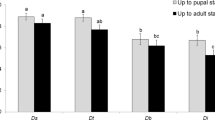Abstract
Key mortality factors of sugar-cane top borer, Scirpophaga excerptalis Wlk. during the third brood were quantified on a susceptible sugar-cane variety, Co 1148 during 1981 and on susceptible CoJ 64, resistant CoJ 67 and collateral hosts, Sorghum halepense Peru, and Saccharum spontaneum L., during 1982 in Haryana (sub-tropical India). As artificial rearing of this borer is not possible, a methodology to have uniform age group at the beginning of the study by tagging the egg masses and the freshly attacked plants was developed. Results showed that parasitization of various stages and failure of neonate larvae to enter the midribs were the key mortality factors common to all the hosts. In 5. halepense there was negative trend index (0.104) due to high mortality of larvae in all the instars. This revealed that it is not a suitable host for top borer. No predators were found to feed on any of the sub-imaginal stages of the borer due to the unique habits of the borer.
Résumé
Les clef mortalité facteur de tête boreur de canne a sucre durant de in re broche wast apprête en variété Co 1148 dans 1981 at pour susceptible CoJ 64, resistant CoJ 67 et collateral hote Sorghum halepense et Saccharum spontaneum en 1983 dans l’état d’Hariana (Inde). Comme artificiet élever a cet égard le boreur ill ne’n le possible, a méthode a la uniforme sucle a’ la commencement a etude etie employe par etiquette d’oeufs anas et nouvelle agress plant. Les résultats de parasitisme du varie stade larvaire et failure de entre de neo larvae dans nervus mediane worst d’clef mortalie facteurs common a aile hote. La negative direction indice dans 5. halepense a cause de elive mortalité d’iarvae en aile stade re vêler et worst ne gut hote. Ne predators worst fund se noueru du subimaginai stade de le boreur a cause de une unique mancere de la boreur.
Similar content being viewed by others
References
Anonymous (1982) Construction of life table for shoot borer, Chilo infuscatellus. Annual Report, Sugar-cane Breeding Institute, Coimbatore.
Clements H.F. and Ghotb A. (1969) The numbering of leaves and internodes for sugar-cane nutrition studies. Proc. 13th Congr. Int. Soc. Sug. Cane Technol. 1968. Taiwan, pp. 569–584.
Dev Roy T.C. and Bains S.S. (1983) Key mortality factors in the population dynamics of sugarcane top borer, Tryporyze nivella (Fabr.) in the Punjab, Proc. Symp. Insect Ecol. Manage. Muzaffarnagar pp. 270–283.
Easwaramoorthy S. and Nandagopal V. (1986) Life tables of internode borer, Chilo sacchariphagus indicus (K.) on resistant and susceptible varieties of sugar-cane. Trop. Pest Manage. 32, 221–228.
Harcourt D.G. (1969) The development and use of life tables in the study of natural insect populations. A. Rev. Entomol. 14, 175–196.
Huque M.W. and Agarwala S.B.D (1955) Biological studies on top borer (Scirpophaga nivella Fab.) Indian Sugar-cane Res. Dev. 5, 13–20.
Kalra A. N. and Chaudhary I. P. (1964) Assessment of losses by sugar-cane pests—loss caused by top borer of sugar-cane. Indian J. Sugar Cane Res. Dev. 8, 261–264.
Lee M.S. and Pao T.P. (1962) A study of ecology and further improvement on the mechanical control of the top borer. Indian J. Entomol. 27, 91–110.
Mukunthan N. (1984) Midrib hardness as a factor in varietal resistance to the sugar-cane top borer, Scirpophaga nivella F. Dec. Sugar-cane Tech. Assoc. 34, A-109-116.
Mukunthan N. (1985) New aspects in the biology of top borer, Scirpophaga nivella F. Entomon 10, 235–238.
Mukunthan N. (1986) The top borer, Scirpophaga excerptalis Wlk. in the Sugarcane Entomology in India (Edited by David H., Easwaramoorthy S. and Jayanthi R.) Sugarcane Breeding Institute, Coimbatore.
Nair K.R., Prakash S. and Nagarkatti S. (1971) A consolidated list of wild and cultivated plant species attacked by sugar-cane borers in north India. ISSCT 14, 435–439.
Nagarkatti S. and Nair K. R. (1973) The influence of wild and cultivated Gramineae and Cyperaceae on populations of sugar-cane borers and their parasites in North India. Entomophaga 18, 419–430.
Patel R. M. (1963) Observations on the life history and control of sugar-cane top borer, Scirpophaga nivella F. in South Gujarat. Indian J. Sugarcane Res. Dev. 8, 50–55.
Slobodkin L.B. (1962) Growth and regulation of animal populations. New York.
Singh O. P. (1978) A note on some new observations on sugarcane top borer Tryporyza nivella F. Indian Sugarcane Crops J. 5, 30.
Varley G.C. and Gradwell G.R. (1960) Key factors in population studies. J. Anim. Ecol. 29, 399–401.
Varley G.C., Gradwell G.R. and Hassel M.P. (1973) Insect Population Ecology: An analytical Approach. Berkely, Univ. Calif. Press.
Wahid H. and Akhtar M.A. (1971) Nutritional requirement of sugarcane top borer Scirpophaga nivella Fab. Pak. J. Zool. 3, 15–21.
Author information
Authors and Affiliations
Rights and permissions
About this article
Cite this article
Mukunthan, N. Life Tables of Sugar-Cane Top Borer, Scirpophaga Excerptalis Wlk.. Int J Trop Insect Sci 10, 269–276 (1989). https://doi.org/10.1017/S1742758400003490
Received:
Revised:
Published:
Issue Date:
DOI: https://doi.org/10.1017/S1742758400003490




